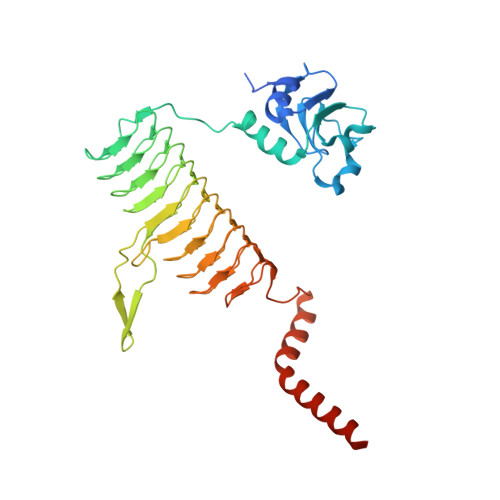Discovery of dual-activity small-molecule ligands of Pseudomonas aeruginosa LpxA and LpxD using SPR and X-ray crystallography.
Kroeck, K.G., Sacco, M.D., Smith, E.W., Zhang, X., Shoun, D., Akhtar, A., Darch, S.E., Cohen, F., Andrews, L.D., Knox, J.E., Chen, Y.(2019) Sci Rep 9: 15450-15450
- PubMed: 31664082
- DOI: https://doi.org/10.1038/s41598-019-51844-z
- Primary Citation of Related Structures:
6UEC, 6UED, 6UEE, 6UEG - PubMed Abstract:
The lipid A biosynthesis pathway is essential in Pseudomonas aeruginosa. LpxA and LpxD are the first and third enzymes in this pathway respectively, and are regarded as promising antibiotic targets. The unique structural similarities between these two enzymes make them suitable targets for dual-binding inhibitors, a characteristic that would decrease the likelihood of mutational resistance and increase cell-based activity. We report the discovery of multiple small molecule ligands that bind to P. aeruginosa LpxA and LpxD, including dual-binding ligands. Binding poses were determined for select compounds by X-ray crystallography. The new structures reveal a previously uncharacterized magnesium ion residing at the core of the LpxD trimer. In addition, ligand binding in the LpxD active site resulted in conformational changes in the distal C-terminal helix-bundle, which forms extensive contacts with acyl carrier protein (ACP) during catalysis. These ligand-dependent conformational changes suggest a potential allosteric influence of reaction intermediates on ACP binding, and vice versa. Taken together, the novel small molecule ligands and their crystal structures provide new chemical scaffolds for ligand discovery targeting lipid A biosynthesis, while revealing structural features of interest for future investigation of LpxD function.
Organizational Affiliation:
Department of Molecular Medicine, University of South Florida, 12901 Bruce B. Downs Boulevard, Tampa, Florida, 33612, United States.
















